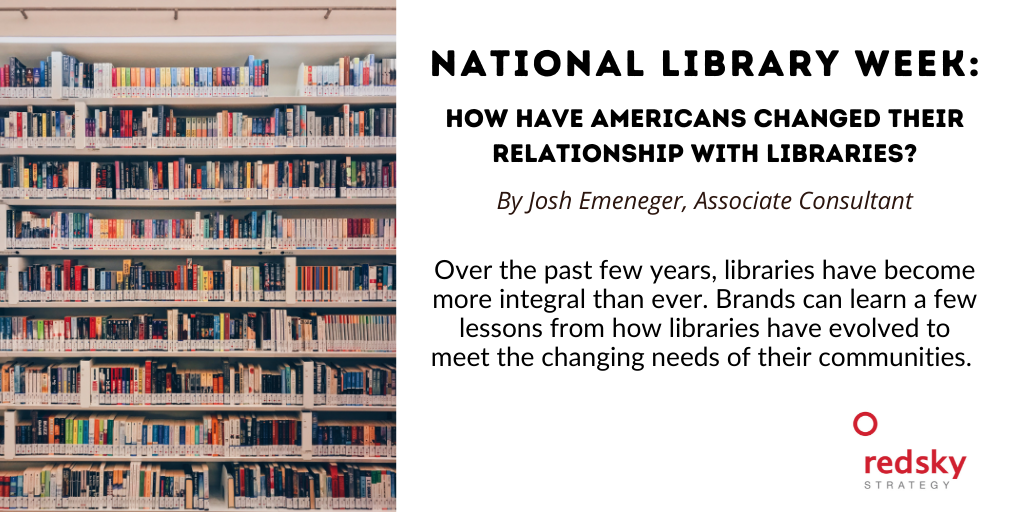News
National Library Week: How Have Americans Changed Their Relationship With Libraries?

Image Credit: https://unsplash.com/photos/55btQzyDiO8
It’s National Library Week, with this year’s theme being “Connect with Your Library”. Now is an appropriate time to see what kind of trends have emerged in this sector, both in regards to the type of books people are reading and what libraries are (and will continue to be) used for.
Libraries are as important as ever to communities–not only do they serve as a place to find books that entertain, inspire, and educate, but they also act as support centers for community members dealing with the lingering effects of COVID.
Most Popular Reads Reflect Societal Trends and Events
Looking at book trends over the past few years, it’s interesting to see how readers’ interests and consumption are reflective of societal trends and occurrences.
Between political unrest, racial injustices, and a global pandemic, the past few years have been a tumultuous time for many. It’s unsurprising that some of the most popular works touch on themes of cultural significance, nostalgia, and stories from authors of color.
The most popular novels checked out from the New York Public Library last year include The Vanishing Half by Brit Bennett, Mexican Gothic by Silvia Moreno-Garcia, and Klara and the Sun by Kazuo Ishiguro. In nonfiction, the most popular titles were President Barack Obama’s memoir A Promised Land and Caste by Isabel Wilkerson.
It seems there’s a growing interest and appreciation for diverse voices. America is more diverse than ever, with 40% of Americans identifying as non-white. People are learning how to talk about themselves in a way that honors their background, and are seeking out narratives that acknowledge the cultural nuances. This goes beyond books; cultural identity resonates with consumers in all categories.
Learning From Libraries
COVID has shown that communities rely on neighborhood libraries to function as more than just a book depository. Over the past two years, they have expanded to become integral institutions in cities and act as commons for citizens.
Libraries can help build healthier communities. A Pew study of Americans found that:
- More than 90% of adults consider public libraries to be “welcoming and friendly places”
- 94% of respondents agree that having a public library improves the quality of life in a community
- 81% of Americans believe public libraries provide many services that people would have a difficult time finding elsewhere
Using Libraries for Post-COVID Community Support
The lingering effects of COVID will be felt for many years. Since 2020, many brands have taken an approach of marketing their products as building community. Fast Company recently highlighted a list of brands that are “connecting with customers through content and community.” For example:
- Chipotle connected with customers by hosting a virtual job fair on Discord and giving out free burritos during a gaming competition on Roblox
- Crypto-exchange FTX established a sports sponsorship strategy involving the Miami Heat’s arena, Tom Brady and Steph Curry, and MLB umpire uniforms
- Peanut-butter brand Jif partnered with Ludacris to issue a #JifRapChallenge on TikTok
In times of isolation, uncertainty, and anxiety, facilitating a sense of connection and support has helped many brands connect with their audiences and demonstrate genuine authenticity and care. Libraries are no exception.
During the pandemic, libraries had to switch gears to act as community support centers. We expect to see this trend continue as they expand to provide ongoing post-pandemic support in various ways. For example, libraries have loaned out WiFi spots, instruments, games, and electronic equipment. Some, including New York City Library, are eliminating late fees.
A recent study highlighted how COVID-19 changed how academic libraries operate and approach their services amidst unexpected facility closures. Many libraries, as with businesses across other industries, had to shift resources to make them available electronically. They also noted a change in recruitment and hiring practices, indicating that the digital nature of meetings allows for a more inclusive and flexible environment with minimum restrictions.
The mission behind this year’s NLW theme of “Connect with Your Library” is to promote the concept of libraries being a place in which community members can go to connect with technology.
Research shows that nearly a quarter of workers will be remote by 2025. This means that libraries will likely have to add more workstations as they could become centers for remote work. The same applies to remote education. Libraries provide access to computers, the internet, and other resources that both students and teachers can utilize to advance education.
Beyond lending out books, libraries also serve as a valuable asset for helping members throughout the community fulfill applications for government, employment, health, housing, and social services.
For instance, the Indianapolis Central Library recently hired its first full-time social worker, Yanna McGraw. Rather than answering questions about books, McGraw spends most of her time helping members navigate the complexities of life, from housing insecurities to the Department of Child Services.
On a broader scale, there’s a growing emphasis on community, particularly in our post-pandemic world. At this point, it’s almost expected for brands to consider themselves part of a wider community, whether that be on a local or global scale. For instance, Apple recently changed its policies to enable people to repair their own devices. This self-sustainable model benefits the community both locally (Apple users) and globally (the planet).
One of the biggest selling points of the Metaverse is the claim that it’s community focused. Another successful brand with a strong community focus is Peloton. In an interview with CNBC, Peloton Chief Marketing Officer Dara Treseder said she attributes the growth to its loyal users sharing their personal experiences with the brand.
“For us, that intentional cultivation of community is really focused on finding where there are organic sparks of connection within our member base, and then kind of pouring fuel on that … shining a spotlight on those things,” she explained.
Organizations across nearly every industry can learn from the support initiatives of libraries. Brands have an opportunity to fulfill unmet needs by branching out to offer support in non-traditional ways. Evolving with the times and innovating based on audiences’ shifting needs and desires places brands in a favorable position to become a valued resource.
Perhaps equally as important, especially in a post-pandemic world, is continuing to take advantage of opportunities to build strong connections and instill feelings of belonging among consumers. By understanding what customers care about, brands can help build and nurture communities that increase engagement and loyalty.
Are you interested in working with RedSky Strategy to shift your perspective and marketing strategies? Our team looks forward to meeting with you, and uncovering how we can use HumanSight™ to illuminate the best pathway to growth for your company.
